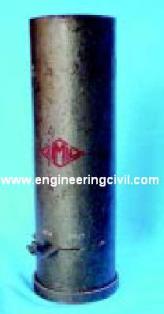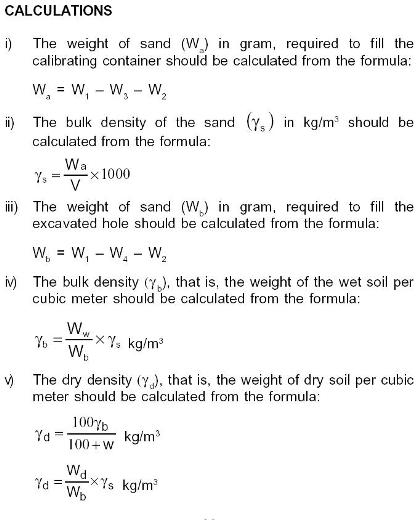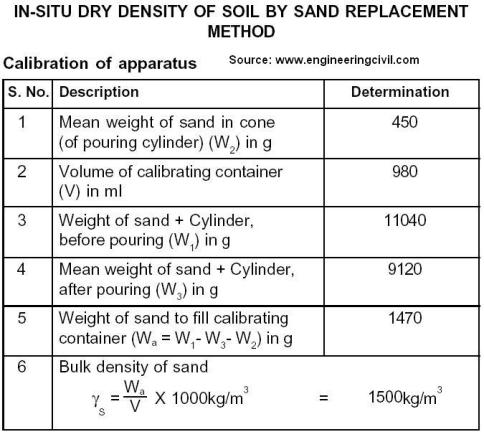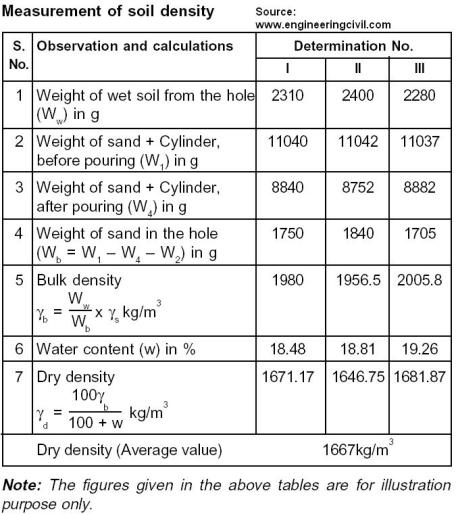This test is done to determine the in-situ dry density of soil by sand replacement method as per IS: 2720 (Part XXVIII) – 1974. The apparatus needed is
i) Sand-pouring cylinder conforming to IS: 2720 (Part XXVIII) -1974
ii) Cylindrical calibrating container conforming to IS: 2720 (Part XXVIII) – 1974
iii) Soil cutting and excavating tools such as a scraper tool, bent spoon
iv) Glass plate – 450mm square and 9mm thick or larger
v) Metal containers to collect excavated soil
vi) Metal tray – 300mm square and 40mm deep with a 100mm hole in the centre
vii) Balance, with an accuracy of 1g

Procedure To Determine The In-Situ Dry Density Of Soil By Sand Replacement Method
A. Calibration of apparatus
a) The method given below should be followed for the determination of the weight of sand in the cone of the pouring cylinder:
i) The pouring cylinder should be filled so that the level of the sand in the cylinder is within about 10mm of the top. Its total initial weight (W1) should be maintained constant throughout the tests for which the calibration is used. A volume of sand equivalent to that of the excavated hole in the soil (or equal to that of the calibrating container) should be allowed to runout of the cylinder under gravity. The shutter of the pouring cylinder should then be closed and the cylinder placed on a plain surface, such as a glass plate.
ii) The shutter of the pouring cylinder should be opened and sand allowed to runout. When no further movement of sand takes place in the cylinder, the shutter should be closed and the cylinder removed carefully.
iii) The sand that had filled the cone of the pouring cylinder (that is, the sand that is left on the plain surface) should be collected and weighed to the nearest gram.
iv) These measurements should be repeated at least thrice and the mean weight (W2) taken.
b) The method described below should be followed for the determination of the bulk density of the sand ( Ys ):
i) The internal volume (V) in ml of the calibrating container should be determined from the weight of water contained in the container when filled to the brim. The volume may also be calculated from the measured internal dimensions of the container.
ii) The pouring cylinder should be placed concentrically on the top of the calibrating container after being filled to the constant weight (W1). The shutter of the pouring cylinder should be closed during the operation. The shutter should be opened and sand allowed to runout. When no further movement of sand takes place in the cylinder, the shutter should be closed. The pouring cylinder should be removed and weighed to the nearest gram.
iii) These measurements should be repeated at least thrice and the mean weight (W3) taken.
B. Measurement of soil density
The following method should be followed for the measurement of soil density:
i) A flat area, approximately 450sq.mm of the soil to be tested should be exposed and trimmed down to a level surface, preferably with the aid of the scraper tool.
ii) The metal tray with a central hole should be laid on the prepared surface of the soil with the hole over the portion of the soil to be tested. The hole in the soil should then be excavated using the hole in the tray as a pattern, to the depth of the layer to be tested upto a maximum of 150mm. The excavated soil should be carefully collected, leaving no loose material in the hole and weighed to the nearest gram(Ww). The metal tray should be removed before the pouring cylinder is placed in position over the excavated hole.
iii) The water content (w) of the excavated soil should be determined as discussed in earlier posts. Alternatively, the whole of the excavated soil should be dried and weighed (Wd).
iv) The pouring cylinder, filled to the constant weight (W1) should be so placed that the base of the cylinder covers the hole concentrically. The shutter should then be opened and sand allowed to runout into the hole.The pouring cylinder and the surrounding area should not be vibrated during this period. When no further movement of sand takes place, the shutter should be closed. The cylinder should be removed and weighed to the nearest gram (W4).
CALCULATIONS

REPORTING OF RESULTS
The following values should be reported:
i) dry density of soil in kg/m3 to the nearest whole number; also to be calculated and reported in g/cc correct to the second place of decimal
ii) water content of the soil in percent reported to two significant figures.
A sample proforma for the record of the test results is given below.


If you have a query, you can ask a question here.



how to calculate sand replacement method to get the percentage campaction of soil or crusher run?
thanking you in advance
Rgds
WIB
how to report and when a results?
i like this web b coz its a usefull site for engineering student ,
how i calulate the density of bitumen with sand replacement method.
To calculate the density of flixible pavement of bitumen ,to be done in laboratory by core test sample taken from site . (sand replacement method test is only for earthwork such as embankment ,structural fill)
By this metod ,how to calculated in-situ density of bitumen pavement.
Hi eng, i need asistant about these question: what are the Applications of consistency limits tests
Objective of atterberg limits tests
i want sand replacement methods formats
i want advantages and disadvantages of core cutter mathod
Am thankful.
keep sending me such notes.
Am a Civil Engineering student in Uganda.
very usefull
the website is very useful to us civil engr.!! from DIT tanzania
the web site is very educative. Pls keep it on.
it is very educative, pls keep eliting us more , tanx.
which one iz better ?
core cutter method vs sand replecement method
It depends on the soil type…..if thr is cohesive soil thn u shd, to adopt core cutter method……the other (sand replecement method) is used for both cohesive, noncohesive and pebbly soil,
Civil engineering is a blast, elite us further.
Am happy to be a civil engineering in NIGERIA. this site helped me in my industrial training report. KEEP THE FLAG FLYING. GOD BLESS
Wll this very gd….engineers your help is needed i wnt to start my project on highway bt i have no materials no even idea?
thanks dear good job dear sir i want to send me the all materials for testing soil density spicific gravaty and etc i am student i want alot of materials thaks for helping
it is very useful for upcoming engineers….awesome
what is the importance cone shape of pouring cylinder in sand replacement method ?